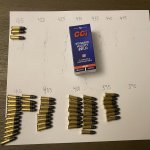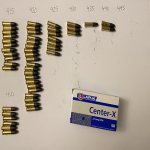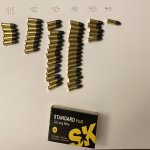Does this book talk about rim thickness at all?
In the chapter on .22LR match ammunition, on page 135, Frost says the following:
Head diameter gauging, which should be 100%, is set to closer limits [for match ammunition] than for standard [non-match] ammunition. The normal specification is .269 - .276". For match, .2710 - .2740" is a good range, although it might have to be adjusted up or down a little for best sensitivity. Any cases gauged out [of match specifications] here can still be used in regular production. Head thickness should be held to .039" - .042" as a rule. (Words in square brackets added for clarification.)
The last sentence is the relevant one regarding rim thickness for .22LR match ammo -- .039" - .042". I couldn't find similar figures for non-match .22LR ammo (of course that doesn't mean they're not there), but there is this diagram below from p. 13 of the Frost book, with a range of sizes given for rim thickness.

If you're interested in the book, there's a physical version of the book available on Amazon.com (US) for $320, which is prohibitively expensive. More practically, there is a pdf available that's
gratis. Let me know if need help locating it.
As for whether sorting rimfire ammunition by rim thickness is worthwhile, there's nothing new to be found. The idea is old, tried, and generally not practiced by experienced shooters because it is found to be time poorly spent. It's most frequent enthusiasts are among newer .22LR shooters who wish to get better accuracy out of inexpensive ammo. Inexpensive ammo is by it's very nature inaccurate ammo. The easiest, most straightforward way to improve accuracy, is to use better quality match ammo. Match ammo is made to more exact specifications. While not every match ammo performs equally well in a particular barrel, it offers the best odds of improved results.
When using match ammo and the results are unsatisfactory, it usually means one of two things. Either the ammo itself is not good, or quite often the barrel and chamber are not up to the expectations. Consistent and excellent results with even good ammo are not common with many mass-produced sporter rifles. They may be achieved on occasion, but they are generally not consistent.






















































 ...I shoot Center-X as my go-to
...I shoot Center-X as my go-to






















